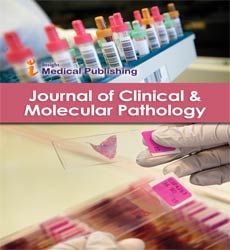ISSN : 2634-7806
Journal of Clinical and Molecular Pathology : Open Access
Antigenic Peptides or Diagnostic Antibodies (Peptide) Used in Pathology Lab
Karim Ayari*
Department of Pathology, University of Sousse Sousse, Tunisia
- *Corresponding Author:
- Karim Ayari, Department of Pathology, University of Sousse Sousse, Tunisia, Tel: 0021255893421; E-mail: karim.ayari7@gmail.com
Received: March 16, 2022, Manuscript No. IPJCMPY-21-12074; Editor assigned: March 19, 2022, PreQC No. IPJCMPY-21-12074 (PQ); Reviewed: April 02, 2022, QC No. IPJCMPY-21-12074; Revised: 5-Apr-2022, Manuscript No. IPJCMPY-21-12074 (R); Published: April 08, 2022, DOI: 10.36648/IPJCMPY/22.6.2
Citation: Ayari K (2022) Antigenic Peptides or Diagnostic Antibodies (Peptide) Used in Pathology Lab. J Clin Mol Patho Vol:6 No:1
Abstract
Molecular pathology is a new discipline of pathology that looks at molecules in organs, tissues and physiological fluids to explore and diagnose disease.
Introduction
Molecular pathology is a new discipline of pathology that looks at molecules in organs, tissues, and physiological fluids to explore and diagnose disease. Anatomic and clinical pathology, molecular biology, biochemistry, proteomics, and genetics, as well as molecular pathology, share various aspects of practice and are sometimes referred to as "crossover" subjects. It is multidisciplinary in nature and focuses on the disease's sub-microscopic characteristics. A key aspect is that a more accurate diagnosis is possible when morphologic abnormalities in tissues (traditional anatomic pathology) and molecular tests are used. It's a branch of science concerned with the development of molecular and genetic methods for diagnosing and classifying human diseases, as well as the development and validation of predictive biomarkers for treatment response and disease progression, and the susceptibility of people with different genetic makeup to develop disorders. Molecular pathology is an important part of diagnostic pathology, especially when it comes to diagnosing infectious disorders. From basic histological examination of tissues to facilitate diagnosis, molecular pathology has come a long way. The significant discoveries in molecular biology and the availability of reagents such as monoclonal antibodies were the key motivations for the creation of this science. In situ hybridization, immunohistochemistry, immunofluorescence, multiplex-staining, and PCR were all developed as a result of the application of molecular biology to histology. Infectious pathogens can be accurately detected and localised in tissue samples using these approaches. These procedures, as well as changes to them, are described in this article for the diagnosis of viral infections. We also go over the benefits, drawbacks, and application of these methodologies in the context of various histological tissues.
Description
Peptides and Antibodies (Abs) have had a beneficial partnership in immunology since their discovery. Despite the fact that the relationship between Abs and Antigens (Ags) had to wait for advances in peptide and protein chemistry, peptide chemistry laid the foundation for understanding protein composition and structure, and Abs laid the platform for molecular immunology. These breakthroughs led to the discovery that Abs and a large number of Ags are proteins. In terms of B cell specificity and development, antigen presentation, and T cell specificity and development, peptides were also crucial reagents in studying the molecular biology of Ab specificity and biosynthesis. In molecular biology, peptides, Abs, and peptide Abs are still employed. This is true not only in terms of research and diagnosis, but also in terms of treatment and disease prevention (vaccination).
Conclusion
Because peptides indicate specific epitopes based on primary sequence structure rather than complete protein secondary or tertiary structure, they trigger antibody production that is less reliant on the target protein being in its native, physiologically active state. Anti-peptide antibodies are more likely to bind native, fixed, and denatured targets, making them ideal for immunohistochemistry, western blotting, ELISA, and immunoprecipitation, among other uses. Peptides are also the only realistic technique to make modification-specific or monospecific antibodies, such as those that bind solely to the phosphorylated form of a target protein. Because both modified and unmodified variants of the peptide can be generated and used to screen or purify antibodies with the necessary specificity, this is conceivable Phosphorylation, acetylation, glycosylation, prenylation, myristolation, ubiquitination, sumoylation, protein cleavage (neo-epitopes), ligand binding, drug binding, polymorphisms, mutations, splice variants, isoforms, species cross-reactivity, and highly conserved proteins are examples of monospecific conditions that necessitate the synthesis of matched peptid.
Open Access Journals
- Aquaculture & Veterinary Science
- Chemistry & Chemical Sciences
- Clinical Sciences
- Engineering
- General Science
- Genetics & Molecular Biology
- Health Care & Nursing
- Immunology & Microbiology
- Materials Science
- Mathematics & Physics
- Medical Sciences
- Neurology & Psychiatry
- Oncology & Cancer Science
- Pharmaceutical Sciences
